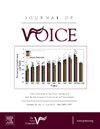摘要
目的:本研究探讨了干燥空气呼吸和雾化吸入各种渗透剂引起的脱水对发声参数(包括知觉、声学和声门电图)的影响:本研究调查了通过干燥空气呼吸和雾化吸入各种渗透剂引起的脱水对发声参数的影响,包括知觉、声学和声门电图测量:30 名嗓音正常的女性(年龄 x̅ = 26,SD = 1.67)参加了连续三天的测试。第一天,在参与者进行 22 分钟的经口干燥空气呼吸之前,对基线数据进行了细致的收集。干燥过程结束后,立即进行测量以确定初步效果。随后,为每位参与者随机选择了三种渗透剂中的一种。这些药剂包括低渗蒸馏水、0.9% 等渗盐水和 3% 高渗盐水。然后,每名参与者使用 5 毫升指定的渗透剂进行 10 分钟的雾化治疗。第二天和第三天重复这一过程。每天,参与者再次进行 22 分钟的经口干空气呼吸。评估方法包括博格 CR-10(感知发声力度)、电子声门图(EGG)、发声时间(VOT)、鼻腔平衡评分(NS)以及使用 CAPE-V 句子(s)进行的前频谱峰值突出分析:初步记录、经口医用级干燥空气协议后、任务-低张力、任务-等张力和任务-高张力后的 EGG 参数在统计学上无明显差异。经口医用级干燥空气方案后,/s1/-CPP 和/s5/-CPP 值与初步记录相比均有所下降。只有 /s1/-CPP 值在 0.9% 等渗盐水雾化后有所增加。与干燥空气方案和雾化后的评分相比,初步测量结果中口鼻和鼻腔文本的 NS 均较高。无声质 VOT 值仅在 0.9% 等渗盐水雾化后有所下降。参与者的 Borg CR-10 评分在经口医用级干燥空气方案后有所上升,而在使用蒸馏水和 0.9% 等渗盐水雾化后有所下降:等渗盐水和蒸馏水雾化方案有减轻经口医用级干燥空气吸入方案对声带参数不利影响的趋势。Objective: This study investigates the effects of dehydration induced by dry air breathing and the nebulization of various osmotic agents on vocal parameters, including perceptual, acoustic, and electroglottographic measures.
Methods: Thirty normophonic females (age x̅ = 26, SD = 1.67) participated over three consecutive days. On the first day, the baseline data were meticulously collected before the participants underwent a 22-minute session of transoral dry air breathing. Immediately after this desiccation protocol, measurements were taken to establish the initial effects. Subsequently, one of three osmotic agents was randomly selected for each participant. These agents included hypotonic distilled water, 0.9% isotonic saline, and 3% hypertonic saline. Each participant then underwent a 10-minute nebulization session with 5 mL of the assigned osmotic agent. The process was repeated on the second and third days. Each day, the participants again experienced the 22-minute transoral dry air breathing session. The evaluations were performed by Borg CR-10 (perceived vocal effort), electroglottography (EGG), voice onset time (VOT), nasalance score (NS), and cepstral peak prominence analyses with CAPE-V sentences (s).
Results: No statistically significant differences were found in the EGG parameters between the preliminary recordings, post transoral medical-grade dry air protocol, and after each of task-hypotonic, task-isotonic, and task-hypertonic. Following the transoral medical-grade dry air protocol, both /s1/-CPP and /s5/-CPP values decreased compared with the preliminary recordings. Only /s1/-CPP values increased after the 0.9% isotonic saline nebulization. NS from preliminary measurements was higher for both oronasal and nasal texts compared with scores after the dry air protocol and nebulization. Voiceless plosive VOT values decreased solely after the 0.9% isotonic saline nebulization. Participants' Borg CR-10 scores increased after transoral medical-grade dry air protocol and decreased after nebulization with distilled water and 0.9% isotonic saline.
Conclusions: Isotonic saline and distilled water nebulization protocols demonstrated a trend toward mitigating the adverse effects of the transoral medical-grade dry air inhalation protocol on vocal parameters.

 求助内容:
求助内容: 应助结果提醒方式:
应助结果提醒方式:


